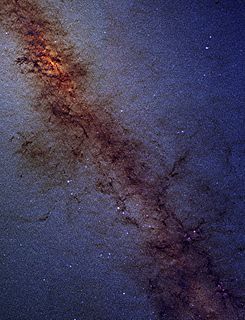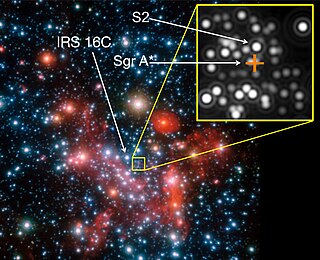Related Research Articles

A black hole is a region of spacetime where gravity is so strong that nothing — no particles or even electromagnetic radiation such as light — can escape from it. The theory of general relativity predicts that a sufficiently compact mass can deform spacetime to form a black hole. The boundary of no escape is called the event horizon. Although it has an enormous effect on the fate and circumstances of an object crossing it, it has no locally detectable features according to general relativity. In many ways, a black hole acts like an ideal black body, as it reflects no light. Moreover, quantum field theory in curved spacetime predicts that event horizons emit Hawking radiation, with the same spectrum as a black body of a temperature inversely proportional to its mass. This temperature is on the order of billionths of a kelvin for black holes of stellar mass, making it essentially impossible to observe directly.
A massive astrophysical compact halo object (MACHO) is a kind of astronomical body that might explain the apparent presence of dark matter in galaxy halos. A MACHO is a body that emits little or no radiation and drifts through interstellar space unassociated with any planetary system. Since MACHOs are not luminous, they are hard to detect. MACHO candidates include black holes or neutron stars as well as brown dwarfs and unassociated planets. White dwarfs and very faint red dwarfs have also been proposed as candidate MACHOs. The term was coined by astrophysicist Kim Griest.

Seyfert galaxies are one of the two largest groups of active galaxies, along with quasars. They have quasar-like nuclei with very high surface brightnesses whose spectra reveal strong, high-ionisation emission lines, but unlike quasars, their host galaxies are clearly detectable.

Spiral galaxies form a class of galaxy originally described by Edwin Hubble in his 1936 work The Realm of the Nebulae and, as such, form part of the Hubble sequence. Most spiral galaxies consist of a flat, rotating disk containing stars, gas and dust, and a central concentration of stars known as the bulge. These are often surrounded by a much fainter halo of stars, many of which reside in globular clusters.

Messier 87 is a supergiant elliptical galaxy with several trillion stars in the constellation Virgo. One of the most massive galaxies in the local universe, it has a large population of globular clusters—about 15,000 compared with the 150–200 orbiting the Milky Way—and a jet of energetic plasma that originates at the core and extends at least 1,500 parsecs, traveling at a relativistic speed. It is one of the brightest radio sources in the sky and a popular target for both amateur and professional astronomers.

A supermassive black hole is the largest type of black hole, with its mass being on the order of millions to billions of times the mass of the Sun (M☉). Black holes are a class of astronomical objects that have undergone gravitational collapse, leaving behind spheroidal regions of space from which nothing can escape, not even light. Observational evidence indicates that almost every large galaxy has a supermassive black hole at the galaxy's center. For example, the Milky Way has a supermassive black hole in its Galactic Center, corresponding to Sagittarius A*. Accretion of interstellar gas onto supermassive black holes is the process responsible for powering active galactic nuclei and quasars.

The Galactic Center is the rotational center, the barycenter, of the Milky Way galaxy. Its central massive object is a supermassive black hole of about 4 million solar masses, which powers the compact radio source Sagittarius A*, which is almost exactly at the galactic rotational center. The Galactic Center is approximately 8 kiloparsecs (26,000 ly) away from Earth in the direction of the constellations Sagittarius, Ophiuchus, and Scorpius, where the Milky Way appears brightest, visually close to the Butterfly Cluster (M6) or the star Shaula, south to the Pipe Nebula.

In astronomy, a galactic bulge is a tightly packed group of stars within a larger star formation. The term almost exclusively refers to the central group of stars found in most spiral galaxies. Bulges were historically thought to be elliptical galaxies that happened to have a disk of stars around them, but high-resolution images using the Hubble Space Telescope have revealed that many bulges lie at the heart of a spiral galaxy. It is now thought that there are at least two types of bulges: bulges that are like ellipticals and bulges that are like spiral galaxies.

An intermediate-mass black hole (IMBH) is a class of black hole with mass in the range 102–105 solar masses: significantly more than stellar black holes but less than the 105–109 solar mass supermassive black holes. Several IMBH candidate objects have been discovered in our galaxy and others nearby, based on indirect gas cloud velocity and accretion disk spectra observations of various evidentiary strength.

Sagittarius A* is a bright and very compact astronomical radio source at the Galactic Center of the Milky Way. It is located near the border of the constellations Sagittarius and Scorpius, about 5.6° south of the ecliptic, visually close to the Butterfly Cluster (M6) and Shaula. Sagittarius A* is the location of a supermassive black hole, similar to massive objects at the centers of most, if not all, spiral and elliptical galaxies.

The Milky Way is the galaxy that includes our Solar System, with the name describing the galaxy's appearance from Earth: a hazy band of light seen in the night sky formed from stars that cannot be individually distinguished by the naked eye. The term Milky Way is a translation of the Latin via lactea, from the Greek γαλακτικός κύκλος, meaning "milky circle." From Earth, the Milky Way appears as a band because its disk-shaped structure is viewed from within. Galileo Galilei first resolved the band of light into individual stars with his telescope in 1610. Until the early 1920s, most astronomers thought that the Milky Way contained all the stars in the Universe. Following the 1920 Great Debate between the astronomers Harlow Shapley and Heber Curtis, observations by Edwin Hubble showed that the Milky Way is just one of many galaxies.

The M–sigmarelation is an empirical correlation between the stellar velocity dispersion σ of a galaxy bulge and the mass M of the supermassive black hole at its center.

S2, also known as S0–2, is a star in the star cluster close to the radio source Sagittarius A* (Sgr A*), orbiting it with a period of 16.0518 years, a semi-major axis of about 970 au, and a pericenter distance of 17 light hours – an orbit with a period only about 30% longer than that of Jupiter around the Sun, but coming no closer than about four times the distance of Neptune from the Sun. The mass when the star first formed is estimated by the European Southern Observatory (ESO) to have been approximately 14 M☉. Based on its spectral type, it probably has a mass of 10 to 15 solar masses.

Sagittarius A or Sgr A is a complex radio source at the center of the Milky Way which contains a supermassive black hole. It is located in the constellation Sagittarius, and is hidden from view at optical wavelengths by large clouds of cosmic dust in the spiral arms of the Milky Way.
CO-0.40-0.22 is a high velocity compact gas cloud near the centre of the Milky Way. It is 200 light years away from the centre in the central molecular zone. The cloud is in the shape of ellipse. The differences in the velocity, termed velocity dispersion, of the gas is unusually high at 100 km/s.

Ton 618 is a hyperluminous, broad-absorption-line, radio-loud quasar and Lyman-alpha blob located near the border of the constellations Canes Venatici and Coma Berenices, with the projected comoving distance of approximately 18.2 billion light-years from Earth. It possesses one of the most massive black holes ever found, with a mass of 66 billion M☉.

NGC 7213 is a lenticular galaxy located in the constellation Grus. It is located at a distance of circa 70 million light years from Earth, which, given its apparent dimensions, means that NGC 7213 is about 75,000 light years across. It was discovered by John Herschel on September 30, 1834. It is an active galaxy with characteristics between a type I Seyfert galaxy and LINER.

NGC 6951 is a barred spiral galaxy located in the constellation Cepheus. It is located at a distance of about 75 million light-years from Earth, which, given its apparent dimensions, means that NGC 6951 is about 100,000 light-years across. It was discovered by Jérôme Eugène Coggia in 1877 and independently by Lewis Swift in 1878.

NGC 3319 is a barred spiral galaxy in the constellation Ursa Major. It was discovered by William Herschel on Feb 3, 1788. It is rich in gas and lacks a galactic bulge.

NGC 3393 is a barred spiral galaxy located in the constellation Hydra. It is located at a distance of circa 180 million light years from Earth, which, given its apparent dimensions, means that NGC 3393 is about 140,000 light years across. It was discovered by John Herschel on March 24, 1835. It is a Type II Seyfert galaxy. The galaxy is known to host two supermassive black holes, which are the nearest known pair of supermassive black holes to Earth.
References
- ↑ National Institutes of Natural Sciences (1 March 2019). "Hiding black hole found". phys.org. Retrieved 1 March 2019.
- ↑ ""Stray Black Holes" discovered in the Galactic Centre – James Clerk Maxwell Telescope". www.eaobservatory.org. 18 July 2017. Retrieved 1 March 2019.